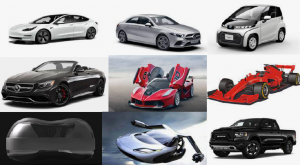
Last updated: 23rd Jan, 2024
Can innovation be taught and learned methodically? Can there be an innovation playbook using which, given a need to create a thing, product, or solve a complex problem, a set of well-defined steps be followed? How has Elon Musk been super successful time and again in creating game-changing innovative products that created tremendous value for end-users and society at large? The answers to these questions can be found with a reasoning technique called first principles thinking.
The first principles thinking is often associated with Elon Musk, who uses this approach to come up with his business ideas, create innovative product designs, and build winning products that create a positive impact on society at large. Through this approach, he has been able to build Tesla, SpaceX, and other innovative and successful companies. As a result, first principles thinking has seen a widespread resurgence in popularity, as more and more people are realizing its potential for innovation in problem-solving, product development, etc. However, different people provide references to first principles in different contexts and there is a need to understand what exactly is first principle thinking. How and when can someone apply first principles thinking for problem-solving?
In this blog post, you will learn about the concepts of First Principles thinking with the help of a few examples. Further details with different examples are available in the book titled “First principles thinking – Building winning products using first principles thinking“. This book can be most suitable for business analysts, product managers, and entrepreneurs who work to innovate and launch new or enhanced products.
What is the first principles thinking?
First principles thinking can be defined as a framework for thinking or a method of reasoning or a thought process in which we try and get to the fundamental truth about the existence of a thing or a problem. And, we do this by breaking things or problems down into different causes in a recursive manner until we arrive at the most fundamental causes. This technique can then be used to innovate new things or solutions by building the argument up from these fundamental causes.
The core objective of this reasoning technique is to understand how things or problems came into existence by arriving at the most basic elements or elementary particles (when viewing from a Physics perspective). In other words, the idea is to understand what went into creating the things or problems. For example, when thinking about a food item such as Pizza, the first principles thinking will result in knowing about how Pizza came into existence in terms of what went into creating Pizza such as raw materials, cooking method, expertise, tools, etc.
Method of Arriving at First Principles – Asking Questions
The process of inquiry or asking questions is key to arriving at the first principles of anything. It is, therefore, very important to understand the kind of questions we need to ask. The following are the four different classes of questions we can get started with and continue to ask while deconstructing things or problems until we arrive at the first principles:
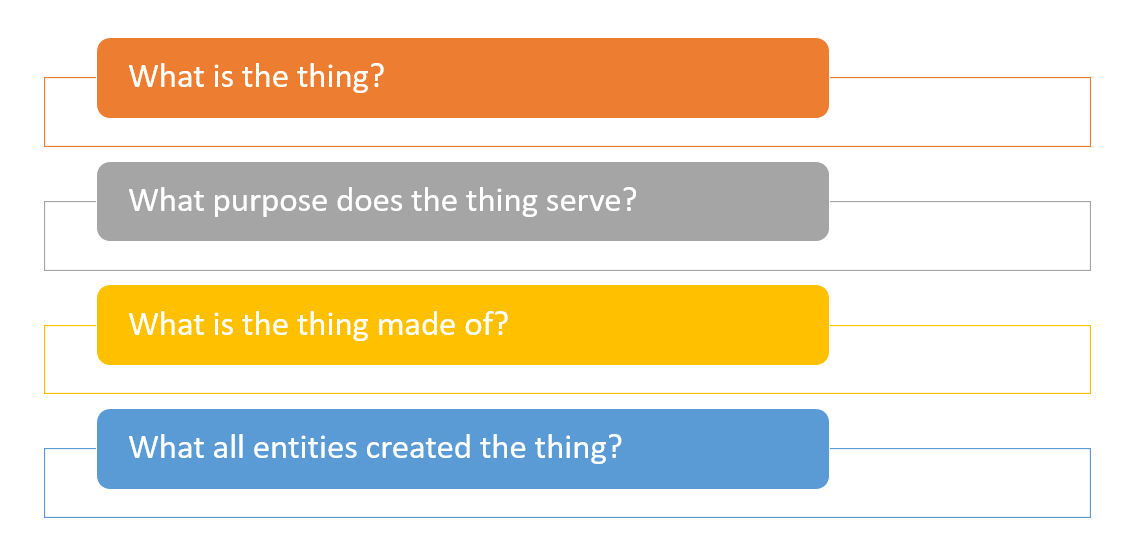
All of the four questions listed above can be related to four different causes discussed later in this blog. As part of analyzing all the causes, we need to look out for answers to the above questions at every level of deconstructing things. When we arrive at the most basic causes, these causes can be referred to as the first causes or the first principles. These first causes or first principles can be thought of as the fundamental truths related to the thing. When deconstructing things or problems into causes based on the cause-and-effect chain, we can ask ourselves whether these causes are the original starting point for the thing or the problem. If not, then continue deconstructing further until we have arrived at the first causes or first principles. This is where the cause-and-effect relationship analysis would help.
First Causes can be called as First Principles
The foundation of first principles thinking can be traced back to Aristotle’s Metaphysics and/or Indian Philosophy. This type of thinking was championed by the ancient Greek philosopher Aristotle, who believed in understanding things at their most basic level to gain a clear understanding of why and how a thing exists. In Aristotle’s Metaphysics, the first principles are defined as “the first causes from which a thing is known”. They are the most fundamental building blocks of anything in this world and can be termed as the “first sources, or, origin“ of the thing. As per Aristotle’s Metaphysics, the first causes or first principles are of four different types namely final, formal, material, and efficient causes. The three of these causes (formal, material & efficient) have also been referred to in Nyaya & Vaisheshika Philosophy in Indian Philosophy. The picture below represents the first causes.
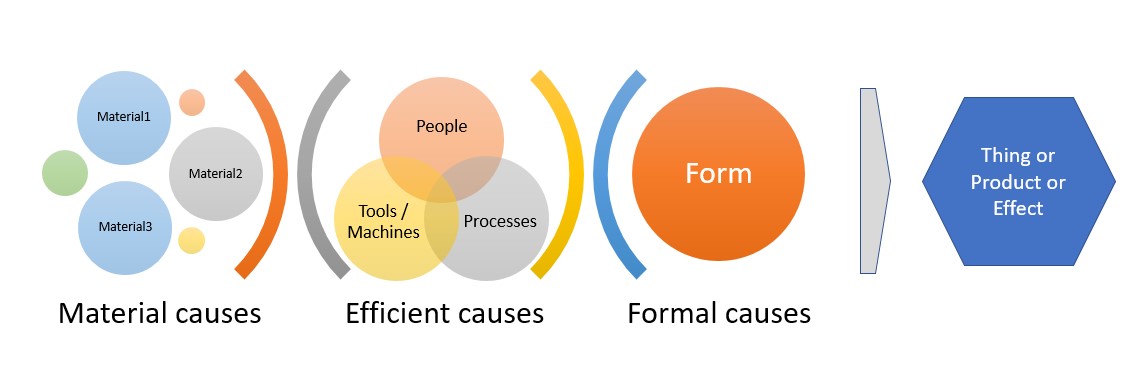
The first causes can be classified into four different categories:
- Final cause: The causes that represent the purpose that the thing serves; The causes that represent the outcome related to a thing or a product. The primary reason why the thing exists in the world.
- Formal cause: The causes that represent the form or the idea or the nature of the thing/product or a problem/solution. Anything or any effect in this world including a problem has a form. The form of the thing can be considered as the definition of the thing based on which a thing can be recognized. Coming up with the true definition of the thing which can include all the instances of that thing in nature (no false positives or false negatives) can be considered the fundamental truth related to the form of the thing. The Socratic questioning method can be very useful in arriving at the most appropriate definition or form of the thing. To start innovating the thing, it is very crucial to arrive at the truth about the definition of the thing. For example, to innovate with the car shown in the picture below, it is very important to come up with the right definition of a car to identify the true form of the car. Ask yourself the question – What is a car? As per the Oxford Dictionary, a car can be defined as a four-wheeled road vehicle that is powered by an engine and can carry a small number of people. If we accept a truth thereby understanding the car as a four-wheeled road vehicle, it will prevent us from thinking about a new form of the car beyond the four-wheeled vehicle. See the picture below. The definition for the form of the car may not include all types of cars, especially, cars that don’t have four wheels. Thus, for innovation purposes, it is of utmost importance to come up with a correct definition of a thing to be accepted as truth about the thing.
- Material causes: The causes that represent the matter, material, or substances of which the thing is made up. The goal is to arrive at the most basic raw materials from which things are made.
- Efficient cause: The causes that represent the entities including persons, processes, tools, etc which are used to create forms (formal causes) from the matters (material causes).
Let’s understand the definitions of first causes with the help of an example given below about cars. Note that the basic form of the car has been innovated to serve the different needs of the end-users (same basic form but different final causes). The picture shows a small car, a Tesla autopilot car, a flying car, a racing car, a sports car, convertibles, an aircar, etc. The cars serving different needs or purposes (final causes) require different raw materials (material causes) and entities (efficient causes) to create them.
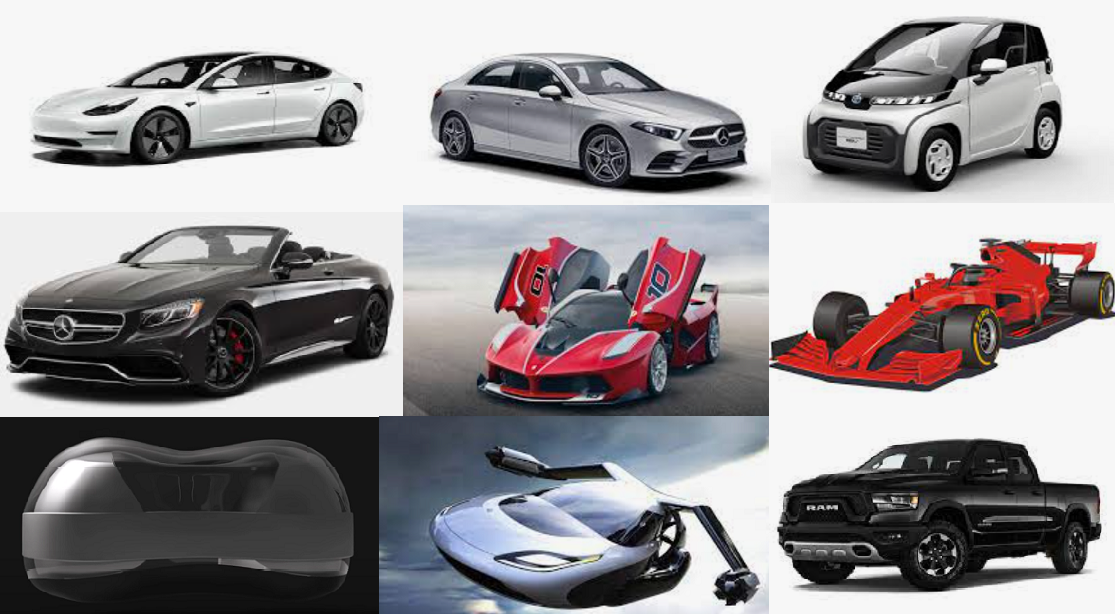
The following is the definition of different types of first causes or first principles explained with the help of the cars shown above.
- The final cause is the purpose served by each of the cars shown above. Note that based on the different final causes, the same car requires different materials to be built along with different entities (tools & technologies & expertise).
- The basic form of the car (formal cause) remained the same. This is why all of them are called cars. That said, each of them has specific forms which originated from the basic form. When deconstructing the formal causes of each of the cars into basic elements, we will arrive at the same basic form for each of the cars.
- The material causes for the cars can be referred to as the materials required to build the car. Note that the materials required for building a racing car will be different than that of a normal car and the same would hold good for other cars as well including flying cars, air cars, etc.
- The efficient causes of the cars will differ in terms of the following:
- Different expertise will be required to the different cars shown above
- Different manufacturing sets may be required
- Different tools & technologies would be required
Building Blocks that help identifying First Principles
The following fundamental concepts need to be understood well if we want to get good with first principles thinking:
- Cause-and-effect: Everything in this world can be thought of as an effect that exists because of different causes. For example, a pot is a thing. It can be understood as an effect that can have causes such as the following. In other words, the pot exists because of the following causes:
- Because the clay was used to build the pot.
- Because the clay was readily available to build the pot.
- Because the person (potter) who makes the pot exists
- Because the person who made the pot is an expert in building clay pots
- Because a set of unique tools such as a wheel and sticks were used to make the clay pot.
- Because the tools were readily available to make the clay pot.
- Because the pot halves were created and joined to make the finished pot (effect)
- Because it has a distinct pot-like shape and size.
- Because it can be used to hold one or more things.
- Because the need to hold one or more things exists.
- Because the need to hold one or more things exists.
- Because the clay was used to build the pot.
- Everything or every effect in this world can be explained in terms of the first principles such as forms, matter (materials), and the entities that create the effect by combining the matter with the forms.
- Everything in this world can be perceived as the composition of one or more things. Some of these things form the basic materials of which the thing is made (also called substance), while other things can just be part of the thing in the form of qualities and actions.
- Everything in the world can be represented in terms of evolution or change from the matter (material or substance) it is made up of to the form it is. And, the change continues to happen until the final purpose or cause is served. In the process of change, the matter continues to acquire new qualities while becoming the form.
- When breaking down a thing into its first causes to acquire knowledge about the thing, we should move from what is clearer and more knowable to us (subjective reality), to what is more knowable and clearer by nature (objective reality) because what is clearer and more knowable to us can just be our perception and not the reality.
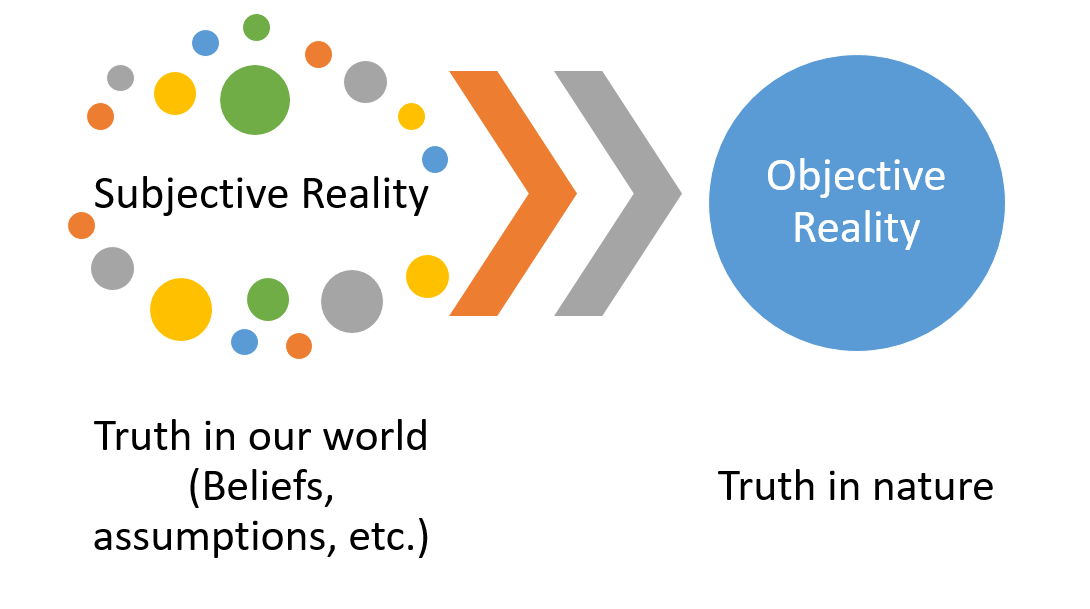
- First principles thinking must start with questioning all assumptions, opinions, and beliefs in a thing, product, or system until you are left with the fundamental truths or components (first principles). The objective is to understand the problem or thing (effect) and its first causes. The questioning techniques play a very important role in arriving at the first causes of a problem or a thing. Different questioning techniques such as the 5-whys, Cartesian method of doubt, the Socratic method, etc can prove to be very handy in understanding different first causes. The 5-why technique helps us arrive at the root causes which can then be traced back to the first causes. The Cartesian method of doubt can help us move from subjective reality to objective reality and know things clearly and distinctly. The Socrates method can help us define things in a precise, clear, and distinct manner. In the following diagram, you may note that the questioning techniques can help us arrive at the root causes related to the problem (undesirable effect). Reasoning by first principles, the root causes can then be categorized in one of the first causes or first principles which then results in an impact on other causes. Implementing the changes across different causes can result in the creation of innovative solutions to the problem thereby creating a new and desirable effect.
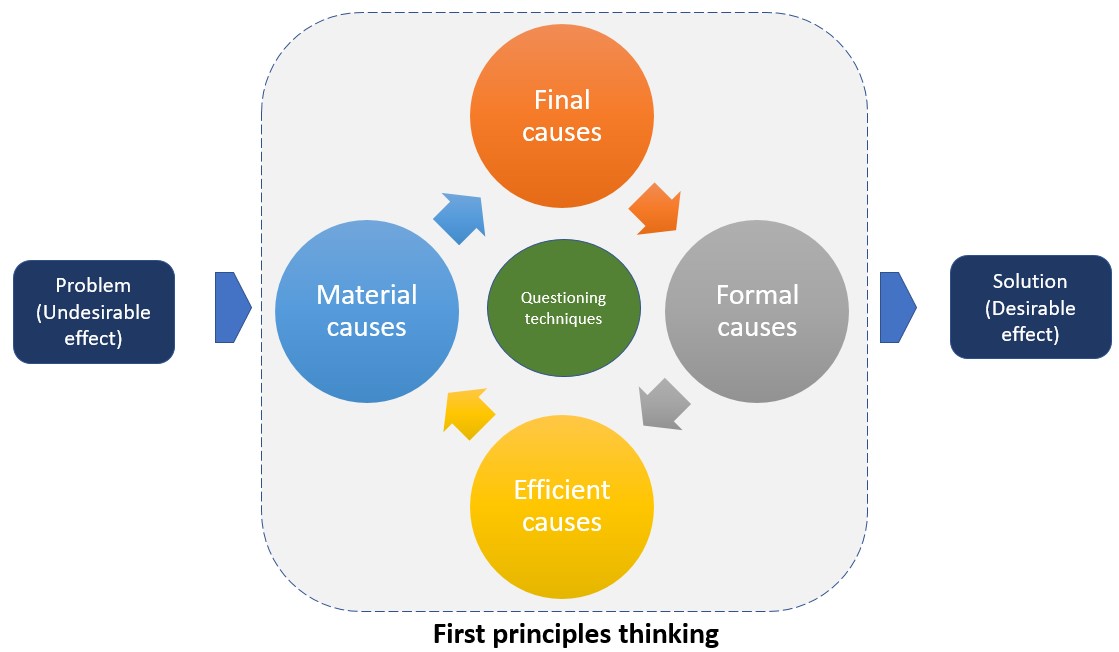
Why reason from first principles?
To understand a thing or a problem in the real world and make impactful decisions, different kinds of reasoning can be used. The most popular ones are as follows:
- Reasoning by analogy (also called analogical reasoning)
- Reasoning by first principles (also called first principle thinking)
One of the most popular ways of reasoning is to reason by analogy which is fundamental to the human thought process. Simply speaking, reasoning by analogy can be defined as understanding one thing in terms of another similar thing. It is a powerful tool that can help us understand complex concepts by relating them to things we are familiar with. Perceived similarities about two or more things are used as a basis for inferring some further similarity that hasn’t yet been observed. For example, let’s say a product A and B have similar properties such as x, y, and z. If product A is observed to have another property such as w, then product B might also have the property w. In other words, if products A and B are similar in several ways, an analogical argument might use product A to explain product B, or to reason about what’s likely true about product B based on what’s known about product A. While reasoning by analogy has been around for centuries, it is not one of the best methods when it comes to creating innovation. This is because, with the reasoning of analogy, you will most likely end up creating similar products with some changes that may not be considered an innovation or breakthrough. This is where reasoning by first principles comes into the picture.
The following is how Musk shared his views on reasoning by analogy vs first principles at a TED conference in 2013:
“We get through life by reasoning by analogy, which essentially means copying what other people do with slight variations. And you have to do that. Otherwise, mentally, you wouldn’t be able to get through the day. But when you want to do something new, you have to apply the [first principles] approach.”
Simply speaking, reasoning by first principles requires you to understand fundamental truths about a thing and then build up your argument from there. This is why reasoning by first principles is more difficult than reasoning by analogy and requires much more mental energy to think through. It is considered to be very suitable for creating innovative products or coming up with creative solutions for complex problems. In the next sections, you will learn a lot of detail about reasoning by first principles also called first principle thinking.
Break down the problem or a thing into first principles
Now that you have learned about the first principles thinking, let’s understand the process you can follow to arrive at the first principles or causes of a thing. This is covered in greater detail in the next chapter. Once the first causes are known, different things of the same type can be innovated by making appropriate changes to any kind of cause. The following figure represents an approach based on which you can break down a problem or a thing into its first causes or first principles.
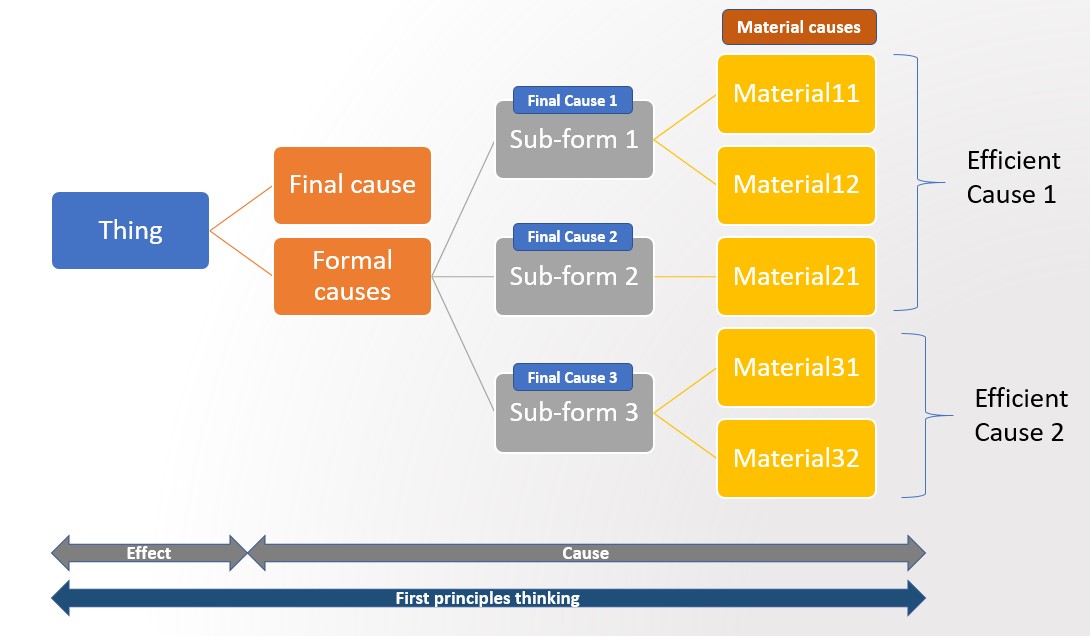
In this figure, note some of the following aspects:
- Things can be understood as an effect that manifests in the form of products (hardware or software) and solutions solving one or more problems, political beings, financial beings, social beings, etc.
- The thing can be broken down into different first causes. Each of these causes can be further split until we arrive at the most basic elements or first causes. Let’s understand the approach with the smartphone example. The following process steps can be followed:
- Start with learning about the final and formal causes. Recall that the final causes represent the purpose served by the thing and the formal cause represents the idea of the thing. When thinking about smartphones, the final cause is calling and internet browsing. One of the formal causes is the most basic nature or the idea of the smartphone such as the touch capability.
- Learn about various sub-forms and associated final causes. When thinking about smartphones, sub-forms include the idea of capturing photos, audio capability for listening to songs, and audio-video capability to watch videos.
- Learn about different materials that can be used to combine with forms and make up the thing. When thinking about smartphones, materials include both external and internal materials.
- Learn about different entities that can be used to build the thing based on the materials and forms while ensuring that final causes are satisfied. When thinking about smartphones, efficient causes represent the vendors/suppliers, staff members, and their expertise, machines, and processes based on which smartphones got created.
You may want to watch this interview of Elon Musk on First principles thinking.
Examples of first principles thinking
Let’s try and understand how first principles thinking can be used to solve different problems. We will take some of the following examples:
- First principles thinking & Lego blocks
- Elon Musk’s rocket project
- Musicians & painters are first principles thinkers
- Chefs apply the first principles thinking
First principles thinking & Lego Blocks
First principle thinking is very useful in building innovative products. Let’s understand this aspect with the help of lego blocks. The first principles can be simply understood as the lego blocks which one can arrive at by dismantling the structures made with Lego blocks (for example, a house built with Lego blocks). Once you have arrived at the fundamental Lego blocks (first sources or causes), you can build new and unique structures with the same Lego blocks. The following picture can be used as the representation of the first principles.
The above lego blocks can be used to build different types of houses such as the following. When applicable to real-world scenarios, you can see one of the houses as a thing (or a product/solution), you are trying to work with. The core idea is to arrive at the individual lego blocks by breaking the house (a thing) into its basic parts (first principles) and then build new things (innovate) from the same lego blocks by combining them in different manners. Look at the following picture to get this understanding of how one can innovate using first principles thinking.
Elon Musk’s rocket project leveraging first principles thinking
In relation to a rocket launch for his space program, Elon Musk, apparently, started shopping for the rocket and found that the price tag of the rocket was astronomical. Elon Musk applied the first principles thinking to design a rocket. The final cause was to come up with a rocket at a lower price tag. The question asked would have been the following: What are the first principles of reality that need to be considered when trying to launch a rocket at a lower price?
The approach could have been to strip the rocket down to its fundamental constituents or elements (material cause), right up to the raw material. Musk made the observation, “Obviously the lowest cost you can make anything for is the spot value of the material constituents. And that’s if you had a magic wand and could rearrange the atoms. So there’s just a question of how efficient you can be about getting the atoms from raw material state to rocket shape.” The raw material costs of a rocket were only 2-3% of the cost of rocket manufacturing. With this end in mind, engineering design and manufacturing processes were determined to align with the company’s strategic business objective of achieving the lowest cost of manufacturing. Careful thought was given to the most effective way of ensuring that each design decision would be cost-efficient. It was decided to design a rocket from a completely blank slate to achieve the lowest cost of manufacturing. By applying vertical integration — principally for cost reasons, around 85% of the entire Falcon/Dragon vehicle was produced in-house — and with the modular approach from software engineering, SpaceX could cut launch price by a factor of ten and still enjoy a 70 percent gross margin. Note that with the change in, primarily, the efficient cause, the overall launch price of the rocket (final cause) got reduced. As a result, this resulted in the innovation of creating and launching rockets at a much lower cost than the market price.
Another deeply held assumption that was questioned based on the first principles is why can’t the rocket be reused. SpaceX has come up with reusable rockets and now with minimal cost, they are innovating in the space program.
Musicians and painters are the first principles thinkers
Did you ever wonder about the process that musicians and painters/artists follow to create some great pieces of music and paintings? They do reasoning by first principles.
In the case of Western music, all the melodies and harmony are typically built from the basic 12 notes. Great musicians know how to mix these notes innovatively to come up with beautiful music. Musical notes represent the potentiality of notes. When it gets combined with the nature or design of music, it takes the shape of musical melodies. The musical notes get actualized. When reasoning from first principles, you work to break down this music in the 12 basic notes. You could then make changes to one or more of these notes innovatively to come up with unique-sounding music. Here are the first principles for music:
- Final cause: Music for different occasions
- Formal cause: Nature of Music
- Material cause: Basic notes and basic beats
- Efficient cause: One or more instruments along with musicians who would play the music
Chefs apply the first principles thinking
Like musicians and painters, great chefs can also be considered as first principles thinkers. When they taste a food item, they apply the first principle thinking to identify ingredients and the process of cooking the food item. Here the material causes represent the basic ingredients and the efficient causes represent the entities that are involved in cooking the food items. Once they get an understanding of the first principles or the first causes, they innovate the same food item by introducing new ideas across different causes.
For coming up with altogether a new dish, they apply first principles thinking to decide on the overall nature or form of the dish, ingredients, and process of cooking the food item.
Knowing first principles using questioning techniques
The important question that arises is how we ensure that we know about true or correct first principles or first causes. The following represents different aspects of knowing first principles:
- What can be considered as knowledge?
- Knowledge of products or things using first principles
- Questioning techniques
This section deals with a lot of details in my upcoming book which you can order here. However, I have tried and provided some useful information here to get you a summary view.
Questioning techniques
The questioning techniques are key to breaking down the thing or product or a problem into first causes. The goal is to arrive at the real or true first causes (knowledge) and this is where it is important to use appropriate questioning techniques. There can be different questioning techniques such as some of the following that can be leveraged with the first principles thinking to create an improved & innovative system.
- The 5-why technique
- Cartesian method of doubt
- Socrates questioning
The questioning techniques such as those listed above can be used to arrive at the first causes such as the final, formal, material, and efficient causes. The diagram below depicts how the questioning techniques can be used to arrive at the first causes that resulted in the problem (undesirable effect) in the first place. Once the root causes are identified and aligned across the first causes, making the appropriate changes to the root causes will result in the creation of a new effect as shown in the following diagram.
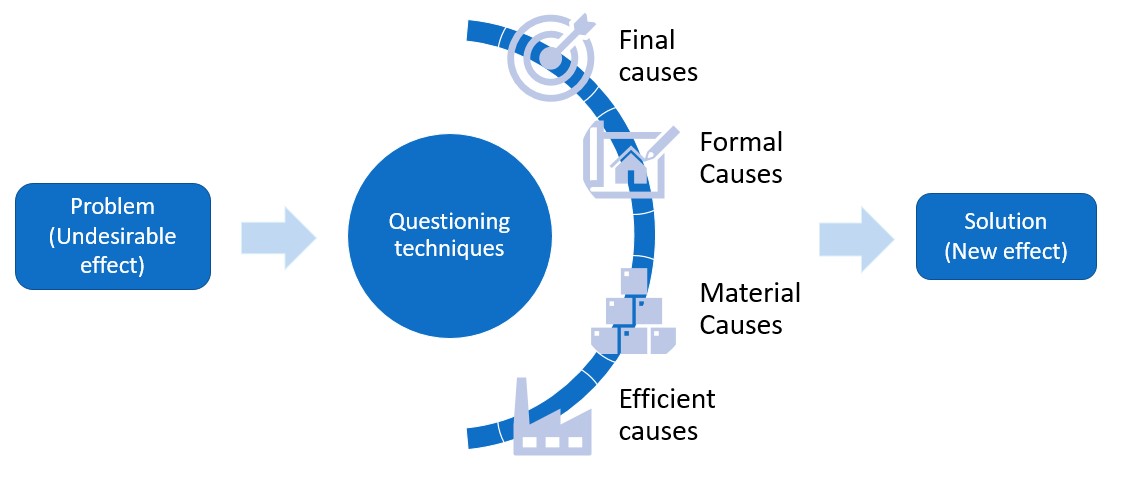
The 5-Whys
The 5-why is one of the most popular techniques to understand cause and effect relationships. It is a great tool for figuring out the root cause of problems. It works by asking “why” five times to drill down into the real issue or cause. The 5-why technique was first popularized by Sakichi Toyoda, founder of Toyota Motor Corporation to help fix problems with machines. The 5-why technique can be used to arrive at any one of the causes including final, formal, material, or efficient causes. Let’s say we want to solve a problem – Why the watch (made for youth) is not having a sale? Here is the 5-why analysis which will help identify different causes:
- 1st Why – Because the price of the watch is higher than the competitive product in the market
- 2nd Why – Because the manufacturing cost is high
- 3rd Why – Because one of the materials used for manufacturing comes at a higher price
- 4th Why – Because the material is imported from remote suppliers.
To start selling the product at a competitive price, what is needed is a change in the efficient causes related to the product to accommodate the lower pricing. To achieve lower pricing, the following can be done. Notice the innovation happening at the material and efficient causes.
- Identify similar materials that can be bought from the local supplier (change in the material cause). This may, however, increase the cost related to the manufacturing process due to the need for different machines (change in efficient cause). You may also end up training existing staff to work with new machines (change in efficient cause)
- Buy the basic raw material and manufacture the material in-house. (Change in the material and efficient cause)
- Get into a long-term partnership with remote suppliers to achieve savings.
Cartesian method of doubt
Cartesian method of doubt is a method adopted by Rene Descartes to doubt everything that he could doubt. This method is based on the principle that suggests that we should doubt all the information and assumptions in front of us. It helps to build a foundation for knowledge that is certain, the knowledge that is different from any preconceived notions, assumptions, hearsay, or beliefs. This technique can be used to solve problems by breaking down the problems into individual steps and questioning the validity of each step.
This technique is very helpful in enabling us to evaluate the thing, product, or problem based on what is true (objective reality) rather than what we consider true in our reality (subjective reality). This will further help us in knowing the truth about the thing or the problem in a holistic manner thereby enabling us to innovate at different levels.
Socratic questioning
The Socratic method is a questioning technique that helps in acquiring knowledge about something in the form of definitions (what?) that can be used to know the first causes in a precise manner thereby guiding a focused set of initiatives and actions. Another word for the Socratic method is Elenchus (a Greek word). Elenchus represents the method of eliciting truth by question and answer, especially as used to refute an argument. In this method, primarily, an argument refutes another argument by proving the contrary of its conclusion. With the first principles thinking, one can use the Socratic method to know about the thing and its first causes or first principles clearly and distinctly. In other words, the Socratic method can be used to acquire knowledge about the problem and solution and define the first causes including final, formal, efficient, and material causes that create both the problem (undesirable effect) and the solution (desirable effect). This would appropriately help take up the initiatives based on formal, material, and efficient causes to create the solution (desirable effect).
Are First Principles Thinking & Analytical Thinking related?
First principles thinking and analytical thinking are indeed interrelated. Analytical thinking is made of the word, “analysis”. Analysis word comes from the ancient Greek ἀνάλυσις (analysis, “a breaking-up” or “an untying;” from ana- “up, throughout” and lysis “a loosening”). When you want to understand anything including a problem in a better manner, you need to break down or loosen up the problem into one or more parts/sub-problems. This aspect can be called analysis. And, the thinking that goes into breaking down the problem or a thing into its constituent parts can be called analytical thinking.
We have also learned that first principles thinking requires breaking down a thing or problem into its most fundamental causes. Thus, it can be implied that analytical thinking is an integral part of the first principles thinking.
References
- Aristotle on Induction and First Principles (umich.edu)
- Aristotle’s method of understanding the first principles of natural things in the Physics
Summary
- Reasoning by analogy requires making an argument about a thing based on its similarities with other things. It is not the most suitable method of creating an innovative product.
- Everything in this world can be understood in the form of a cause-and-effect relationship. A thing is called an effect and some causes bring this effect into play.
- As per Aristotle’s Metaphysics, the primary causes are final, formal, material, and efficient causes.
- The primary causes can be called first causes or first principles.
- First principles thinking is about acquiring knowledge about a thing by knowing its first causes.
- First principles thinking is about decomposing a problem or a thing into its most basic elements which can be termed as first causes.
- The final cause is about the purpose that the things serve.
- The formal cause is about the nature of the thing. Simply speaking, the formal cause represents the design or structural blueprint of the thing.
- The material cause represents the materials that compose the thing. The material with form makes up the thing.
- The efficient cause represents the entities that are responsible for bringing together materials and forms together to make up the thing.
- First principles thinking can be used to build innovative products by innovating across different causes.
If you liked the post and want to learn more about this topic in detail then you may grab this book titled “First principles thinking – Building winning products using first principles thinking“. I hope that with these insights, you will be able to innovate your next product offerings. Please feel free to drop a message and share your comments or feedback.
- Mathematics Topics for Machine Learning Beginners - July 6, 2025
- Questions to Ask When Thinking Like a Product Leader - July 3, 2025
- Three Approaches to Creating AI Agents: Code Examples - June 27, 2025

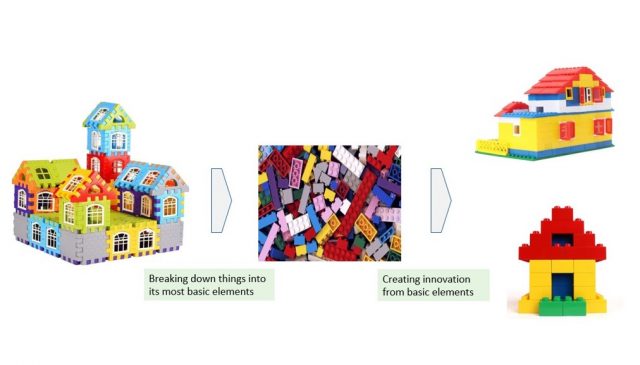
Hi, Ajitesh!
I loved your article and would like to attend the workshop.
Could you give me more informations?
Thank you very much!
Thanks Marcus for reaching out. I am in the process of designing the program and creating the material. Will keep you posted once it gets ready.
Thank you for a detailed post. Very helpful, indeed!
What is the difference between Cartesian method of doubt and the Socratic questioning method?
While the Cartesian method of doubt helps in knowing things for certain, the Socratic method helps in understanding the form of the thing in a precise manner. In case, you are looking to determine the formal cause of a thing, use the Socratic method. In case, you want to know about the different causes of the thing for certain (objective reality), use the Cartesian method of doubt.
This is not first principles thinking. bad interpretation. The fundamentals of logic: do you have the right axioms? are they relevant? are you making the right conclusions based on those axioms? Without violating any of the fundamental laws etc. You can only learn counter-intuative concepts on top of this if you study physics
Thank you for sharing your opinion. First principles thinking has its roots in Philosophy with different interpretations such as the one referred to in relation to Physics (Axioms). We need to understand what are Axioms. Isn’t the statement or proposition which is self-evidently true be called Axiom? So, basically, we are still talking about arriving at the truth (in objective reality space) and then building our argument from there to understand the thing. And the truth about anything can be understood in terms of how the thing came into existence (formal, material, and efficient causes) and why the thing exists (final cause).
Thank for this article